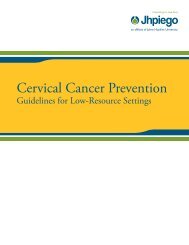Manual for Male Circumcision under Local Anaesthesia
Manual for Male Circumcision under Local Anaesthesia
Manual for Male Circumcision under Local Anaesthesia
Create successful ePaper yourself
Turn your PDF publications into a flip-book with our unique Google optimized e-Paper software.
<strong>Male</strong> circumcision <strong>under</strong> local anaesthesia<br />
Version 3.1 (Dec09)<br />
Effects of circumcision<br />
After the operation, the head of the penis is exposed all the time. The skin on the shaft of the<br />
penis is left intact. In adults, it is left slightly loose to allow enough skin <strong>for</strong> erection. The<br />
penis looks different and this may take some getting used to. It takes some months <strong>for</strong> the<br />
stitch marks to fade completely.<br />
Benefits of circumcision<br />
There is more and more evidence that men who are circumcised have a lower risk of<br />
catching HIV infection. In countries where most men are circumcised, the number of people<br />
with HIV is much lower than in countries where most men are not circumcised. However,<br />
male circumcision gives only partial protection against HIV infection; correct and consistent<br />
use of condoms is the best <strong>for</strong>m of protection. Other ways of reducing the risk of acquiring<br />
HIV infection include not having sex and reducing the number of sexual partners. Sexual<br />
behaviour remains the most important factor in HIV transmission. Avoiding multiple partners<br />
and high-risk sexual behaviour, and always using condoms, reduce substantially the risk of<br />
acquiring or transmitting HIV.<br />
<strong>Circumcision</strong> also reduces the risk of some other sexually transmitted infections, such as<br />
herpes and genital ulcers.<br />
Sometimes circumcision is per<strong>for</strong>med <strong>for</strong> medical reasons, such as when the <strong>for</strong>eskin is too<br />
tight to be pulled back from the glans. After circumcision, it is much easier to wash the head<br />
of the penis and keep it clean.<br />
Problems and complications after the operation<br />
Immediate problems<br />
Some swelling and discom<strong>for</strong>t can be expected after the operation, but this normally gets<br />
better after the first day or two. No special treatment is needed.<br />
One of the possible complications of circumcision is bleeding or accumulation of blood <strong>under</strong><br />
the skin. This is because the skin of the penis is less tight than other parts of the body and<br />
has a very good blood supply. If a large blood clot <strong>for</strong>ms, it is sometimes necessary to<br />
per<strong>for</strong>m another small operation to remove it. If this happens, it may be necessary to stay in<br />
hospital <strong>for</strong> a few days and rest <strong>for</strong> a week or two.<br />
The wound can become infected, particularly in men with diabetes. The operation is<br />
per<strong>for</strong>med in sterile conditions, but the penis is in an area that is not as clean as other parts<br />
of the body. The first signs of infection are increasing pain, redness and swelling at the site<br />
of the operation. If this happens, you should return to the clinic <strong>for</strong> follow-up, as antibiotic<br />
treatment may be needed. Antibiotics are not given routinely and antibiotic ointment should<br />
not be used unless given to you by a nurse or doctor. The actual risk of having a<br />
complication, such as bleeding or infection, is about one <strong>for</strong> every fifty men who have the<br />
operation.<br />
If you are unable to pass urine or have any difficulty in doing so, you should return to the<br />
clinic <strong>for</strong> assessment.<br />
Educating and Counselling Clients and Obtaining In<strong>for</strong>med Consent Chapter 3-20
















